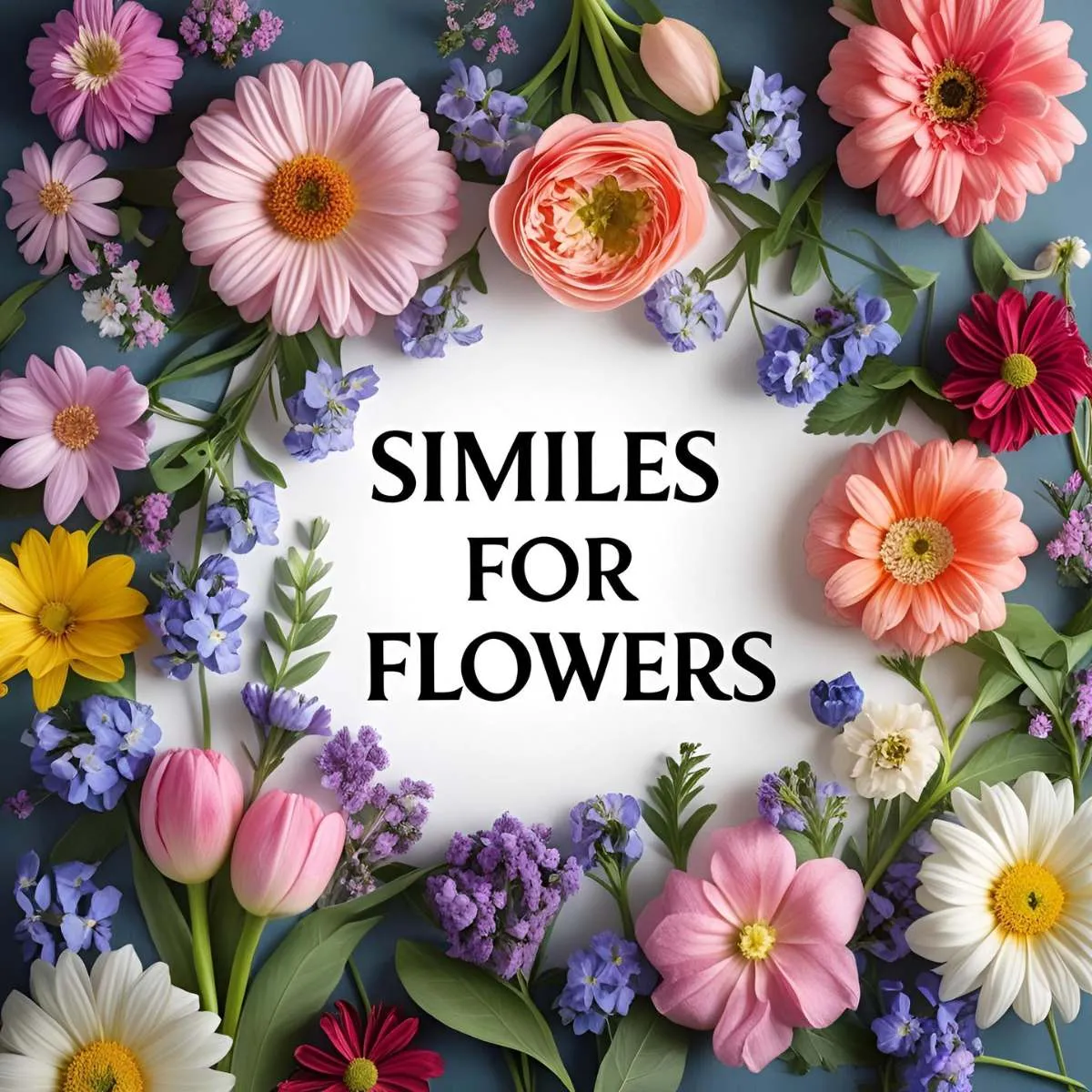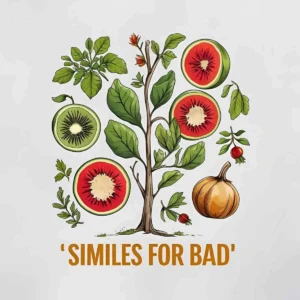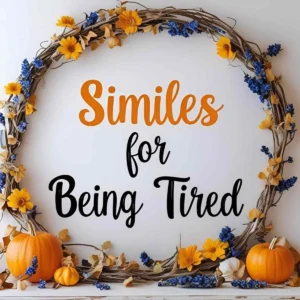The Petal-Soft Power of Similes 🌼
Similes are like dewdrops on petals, sparkling with comparisons that use “like” or “as” to make language bloom. They turn simple descriptions into vivid, relatable images, transforming “The flower is pretty” into “The flower glows like a sunrise, warming the garden.” Similes bring flowers—symbols of beauty, growth, and resilience—to life in writing, speech, or even casual chats. Whether you’re penning a poem, crafting a story, or captioning a garden selfie, similes make your words unforgettable. Ready to let your language flourish? Let’s explore 25 unique similes for flowers, grouped by theme, to inspire your creative garden! 🌷
Similes for Flowers: 25 Vivid Comparisons
These 25 similes capture the essence of flowers— their beauty, fragility, strength, and cultural significance. Organized into thematic categories, each simile includes a meaning, a contextual example, and a specific application for writing, speaking, or social media. Let’s watch these floral comparisons blossom!
Flowers in Radiant Beauty 🌺
Similes highlighting flowers’ stunning appearance and charm.
- Flowers glow like lanterns, lighting up the meadow.
Meaning: Flowers shine with vibrant beauty, like lanterns casting a warm glow.
Example: In a nature poem, “The daisies glowed like lanterns, brightening the dusk-lit field.”
Application: Use in a travel blog or Instagram caption, e.g., “These tulips glow like lanterns in Amsterdam’s gardens! 🌷” - Flowers sparkle like jewels, dazzling in the sunlight.
Meaning: Flowers shimmer with vivid colors, like gems catching light.
Example: In a garden scene, “The roses sparkled like jewels, stealing the show in her yard.”
Application: Perfect for descriptive essays or a Pinterest post about floral arrangements. - Flowers dance like flames, flickering with vivid hues.
Meaning: Flowers move with vibrant energy, like flames swaying in a breeze.
Example: In a festival story, “The marigolds danced like flames, igniting the celebration.”
Application: Use in a cultural blog or a caption for a festival photo. - Flowers shimmer like stars, twinkling in the garden’s sky.
Meaning: Flowers gleam with delicate beauty, like stars in a night sky.
Example: In a romantic story, “Her bouquet shimmered like stars, mirroring her radiant smile.”
Application: Great for wedding vows or a love letter describing a floral gift. - Flowers bloom like fireworks, bursting with color.
Meaning: Flowers explode with vibrant hues, like fireworks in a display.
Example: In a park scene, “The peonies bloomed like fireworks, stunning every passerby.”
Application: Use in a nature journal or a tweet about a flower market visit.
Flowers in Gentle Grace 🌿
Similes for flowers’ delicate, serene qualities.
- Flowers sway like ballerinas, pirouetting in the breeze.
Meaning: Flowers move gracefully, like dancers performing a delicate routine.
Example: In a spring poem, “The tulips swayed like ballerinas, twirling in the morning wind.”
Application: Use in poetry or a caption for a garden video, e.g., “Lilies swaying like ballerinas today! 💃” - Flowers are whispers, murmuring secrets to the wind.
Meaning: Flowers convey quiet beauty, like soft whispers in a conversation.
Example: In a reflective essay, “The violets were whispers, sharing secrets with the dawn.”
Application: Perfect for meditative writing or a journal entry about a quiet walk. - Flowers drift like clouds, soft and fleeting in the garden.
Meaning: Flowers seem light and transient, like clouds floating across the sky.
Example: In a nature story, “The cherry blossoms drifted like clouds, delicate and brief.”
Application: Use in a travel memoir or a post about spring blooms. - Flowers are teardrops, glistening with tender beauty.
Meaning: Flowers hold delicate, emotional charm, like teardrops reflecting light.
Example: In a memorial scene, “The lilies, teardrops of the garden, mourned in silence.”
Application: Great for eulogies or a heartfelt card for a loved one. - Flowers flutter like butterflies, delicate and free.
Meaning: Flowers move lightly, like butterflies dancing in the air.
Example: In a children’s book, “The pansies fluttered like butterflies, delighting the meadow.”
Application: Use in a kids’ story or a classroom poster about nature.
Flowers as Symbols of Strength 💪
Similes for flowers’ resilience and endurance.
- Flowers stand like sentinels, guarding the earth’s beauty.
Meaning: Flowers remain steadfast, like guards protecting a fortress.
Example: In an environmental essay, “The wildflowers stood like sentinels, defending the hillside.”
Application: Use in a speech about conservation or a blog about native plants. - Flowers rise like phoenixes, reborn from winter’s ashes.
Meaning: Flowers bloom anew after hardship, like mythical birds rising from flames.
Example: In a gardening blog, “The crocuses rose like phoenixes, defying the frost.”
Application: Perfect for motivational posts or a journal about personal growth. - Flowers are warriors, battling storms with quiet strength.
Meaning: Flowers endure challenges, like warriors facing battles.
Example: In a storm scene, “The sunflowers, warriors of the field, stood tall against the rain.”
Application: Use in a resilience speech or a caption for a stormy garden photo. - Flowers cling like climbers, scaling life’s challenges.
Meaning: Flowers persist through adversity, like climbers ascending a mountain.
Example: In a survival story, “The desert blooms clung like climbers, thriving in the heat.”
Application: Great for adventure writing or a post about overcoming obstacles. - Flowers are anchors, rooted deep in hope.
Meaning: Flowers stay grounded, like anchors holding fast in a storm.
Example: In a hope-themed poem, “The daisies, anchors of the meadow, held firm in hope.”
Application: Use in inspirational writing or a card for someone facing hardship.
Flowers in Emotional Moments ❤️
Similes for flowers’ role in love, memory, and connection.
- Flowers are love letters, blooming with heartfelt words.
Meaning: Flowers express deep emotions, like letters written from the heart.
Example: In a romance novel, “The roses were love letters, confessing his feelings in red.”
Application: Use in a wedding toast or a Valentine’s Day post. - Flowers are memories, holding moments like keepsakes.
Meaning: Flowers preserve special times, like keepsakes in a box.
Example: In a memoir, “The lavender, a memory, held her grandmother’s garden in its scent.”
Application: Perfect for nostalgic essays or a tribute post for a loved one. - Flowers smile like friends, brightening gloomy days.
Meaning: Flowers uplift spirits, like friends offering a cheerful grin.
Example: In a journal entry, “The sunflowers smiled like friends, chasing away my blues.”
Application: Use in a mental health blog or a card to cheer someone up. - Flowers are hugs, wrapping hearts in soft petals.
Meaning: Flowers offer comfort, like warm embraces.
Example: In a hospital scene, “The lilies, hugs in bloom, comforted her bedside.”
Application: Great for a get-well-soon note or a post about visiting a friend. - Flowers sing like lullabies, soothing weary souls.
Meaning: Flowers bring calm, like gentle songs for rest.
Example: In a bedtime story, “The jasmine sang like a lullaby, lulling the garden to sleep.”
Application: Use in a relaxation guide or a caption for a serene garden photo.
Flowers in Cultural Contexts 🌍
Similes inspired by cultural or historical significance.
- Flowers are poets, weaving verses in every petal.
Meaning: Flowers tell stories through their beauty, like poets craft lines.
Example: In a cultural novel, “The lotus, a poet, wove tales of ancient rivers.”
Application: Use in a literary essay or a post about a cultural festival. - Flowers dance like drummers, pulsing with tradition’s rhythm.
Meaning: Flowers embody cultural vibrancy, like drummers set a beat.
Example: In a festival scene, “The marigolds danced like drummers, pulsing with Diwali’s joy.”
Application: Perfect for a cultural blog or a caption for a festival photo. - Flowers are tapestries, stitching heritage into blooms.
Meaning: Flowers reflect cultural roots, like tapestries weave history.
Example: In a travel memoir, “The cherry blossoms, tapestries of Japan, stitched spring’s story.”
Application: Use in a travel journal or a speech about cultural pride. - Flowers are oracles, whispering ancient wisdom.
Meaning: Flowers carry timeless insights, like oracles share prophecies.
Example: In a historical story, “The roses, oracles of the garden, whispered medieval secrets.”
Application: Great for historical fiction or a post about heritage gardens. - Flowers are alchemists, turning sunlight into beauty.
Meaning: Flowers transform nature’s gifts into art, like alchemists create gold.
Example: In a science essay, “The orchids, alchemists of the jungle, turned rays into radiance.”
Application: Use in a biology project or a caption for a botanical garden visit.
Creative Examples to Inspire Your Muse 🌻
These similes make flowers leap off the page. “Flowers sway like ballerinas” paints a garden as a delicate dance, perfect for a springtime poem. “Flowers are love letters” captures romance, ideal for a wedding vow. Ever thought of flowers as “alchemists”? Try it when describing a vibrant bouquet! Which simile feels like your garden—do your flowers glow like lanterns or stand like sentinels?
Try This: Pick a simile and write a sentence about a flower you saw today, like “My roses glowed like lanterns in the sunset.” Share it in a text or journal!
Practical Applications for Every Bloom 📝
These similes can transform your communication:
- Poetry: Use “flowers dance like flames” to add vibrancy, e.g., in a poem about a festival.
- Stories: Add “flowers are teardrops” to a memorial scene for emotional depth.
- Speeches: Say “We’re flowers, rising like phoenixes” in a graduation speech to inspire resilience.
- Social Media: Post “My garden’s smiling like friends today! 🌼” for a cheerful vibe.
- Everyday Chats: Toss “These daisies are hugs!” into a conversation about a gift bouquet.
Challenge: Rewrite a dull sentence, like “I saw flowers,” to “I saw flowers sparkling like jewels.” Notice how it blooms!
Conclusion: Let Your Words Flower 🌹
Similes are your garden tools for making language vibrant. From “fireworks” bursting with color to “tapestries” weaving heritage, these comparisons turn flowers into stories, emotions, and art. So, plant a simile in your next project—maybe “My roses are poets” in a poem or a tweet. Better yet, create your own: are your flowers “comets” streaking with beauty? Share it with a friend or post it to spark joy. Your words are a garden—let them bloom wildly! 🌸



